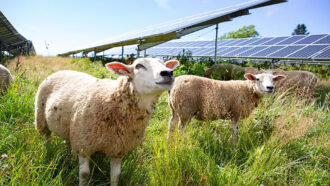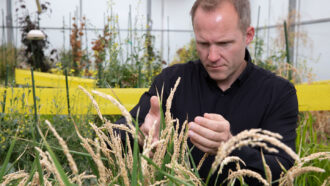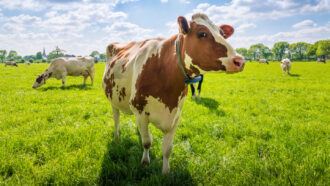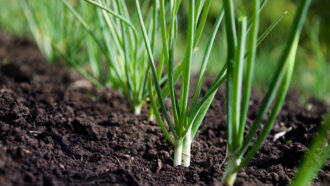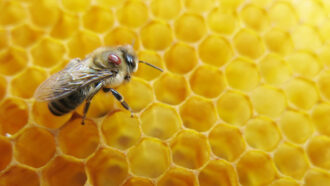A shock to the food system
Bad weather in many parts of the world at once could limit the global food supply
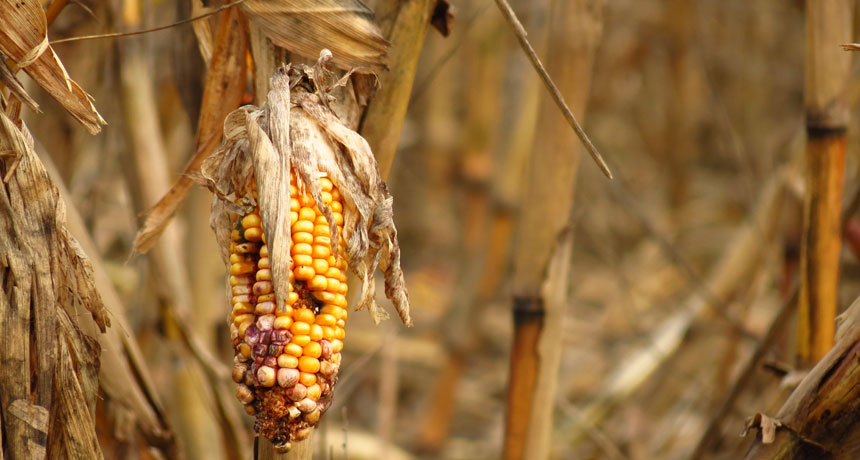
A drought can dry out what had looked like a healthy crop. Too many simultaneous floods, droughts and other extreme events worldwide could sent the globe into “food shock.”
ommb/istockphoto
By Sid Perkins
WASHINGTON, D.C. — Feeding the world’s population is a big challenge, and it’s about to get bigger. Right now, a little more than 7.3 billion people share the planet. Most nights, many go to bed hungry. By 2050, some scientists estimate, the world’s population may reach 9 billion. Earth’s changing climate will probably make feeding this far greater number a very daunting task. That was the conclusion of several scientists here, February 12, at the annual meeting of the American Association for the Advancement of Science (AAAS).
Just three crops — wheat, rice and maize (commonly known as corn) — provide more than two-thirds of the calories that people consume. Such cereals, and a small number of other important crops, come from farming regions sometimes referred to as “breadbaskets.” These fertile areas often occupy relatively small portions of the globe, says Tim Benton. He works at the University of Leeds in England. As a population ecologist, he studies how changes in the environment influence such things as the numbers of species in an ecosystem.
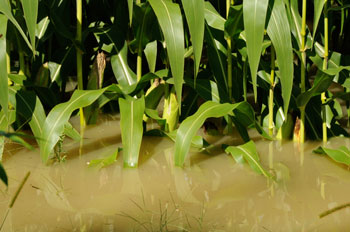
Worse than bad weather in one of these areas would be crop-crippling weather in two or more, says Joshua Elliott. He’s an environmental scientist at the Computation Institute in Chicago, Ill. (This is a program of the University of Chicago and nearby Argonne National Laboratory.) Elliott is an expert in using computer models to simulate the effects of weather and climate change.
Big crop failures in two or more breadbaskets could lead to what researchers call a “food shock,” he notes. An overall shortage of food might result. Afterward, some nations would likely restrict the sale to other countries of some foods that are now in short supply. And this could quickly worsen the effects of the food shortage, says Elliott, as many nations had to find new sources of these crops.Extreme food shocks used to happen perhaps once every century. Put another way, that’s only about once in every four generations of people. But climate change is boosting the risk that new food shocks will emerge, Elliott notes. Many studies suggest that as the climate warms, high and low temperatures will become more extreme. Also, weather may become more variable from one year to the next. That would be make it more difficult for farmers. They depend on predictable temperatures and rainfall.
Some climate studies now predict that by 2050, food shocks could occur about once every 30 years. In other words, a person born in the middle of the current century might live through two or three extreme food shocks during their lifetime. By comparison, someone born in 1950 would have seen one or none.
So what can people do to help avoid food shocks? Making agriculture more efficient is one option, says Elliott. Another possibility: Governments could relax rules that earmark certain amounts of corn for biofuel. Then, in times of food shortage, more corn could end up in someone’s belly rather than a vehicle’s gas tank.
But one of the most effective ways to combat food shocks might be to cut down on food waste, said Seth Cook. He’s an environmental scientist at the International Institute for Environment and Development in London, England. More than one-third of the world’s crop harvest is lost each year, Cook reported at the meeting. In developing countries, a lot of food spoils due to a lack of refrigeration. In other instances, insects or rodents may eat grains while they are in storage.
And in industrial nations, people often feel they need to throw away food because it doesn’t look good. Others toss what has passed the “sell by” date stamped on a container. In both cases, the food might be perfectly edible, notes Cook.
“If we could cut food waste in half,” Cook argues, “we could feed an extra billion people.”
Power Words
(for more about Power Words, click here)
agriculture The growth of plants, animals or fungi for human needs, including food, fuel, chemicals and medicine.
breadbasket A colloquial term for a region where many cereal grains — corn, rye, wheat and sorghum — are grown
cereals (in agriculture) A term for a family of related crops, also known as grains, that include maize (or corn), rice, wheat, barley and sorghum.
climate The weather conditions prevailing in an area in general or over a long period.
climate change Long-term, significant change in the climate of Earth. It can happen naturally or in response to human activities, including the burning of fossil fuels and clearing of forests.
computer model A program that runs on a computer that creates a model, or simulation, of a real-world feature, phenomenon or event.
developing country A poorer country with relatively little industry and a lower standard of living than industrial countries, such as the United States and Canada.
ecosystem A group of interacting living organisms — including microorganisms, plants and animals — and their physical environment within a particular climate. Examples include tropical reefs, rainforests, alpine meadows and polar tundra.
environment The sum of all of the things that exist around some organism or the process and the condition those things create for that organism or process. Environment may refer to the weather and ecosystem in which some animal lives, or, perhaps, the temperature, humidity and placement of components in some electronics system or product.
environmental science The study of ecosystems to help identify environmental problems and possible solutions. Environmental science can bring together many fields including physics, chemistry, biology and oceanography to understand how ecosystems function and how humans can coexist with them in harmony.
fertile (in agronomy) Soils rich in nutrients and able to sustain plant growth.
global warming The gradual increase in the overall temperature of Earth’s atmosphere due to the greenhouse effect. This effect is caused by increased levels of carbon dioxide, chlorofluorocarbons and other gases in the air, many of them released by human activity.
insect A type of arthropod that as an adult will have six segmented legs and three body parts: a head, thorax and abdomen. There are hundreds of thousands of insects, which include bees, beetles, flies and moths.
model A simulation of a real-world event (usually using a computer) that has been developed to predict one or more likely outcomes.
population (in biology) A group of individuals from the same species that lives in the same area.
simulate To deceive in some way by imitating the form or function of something. A simulated dietary fat, for instance, may deceive the mouth that it has tasted a real fat because it has the same feel on the tongue — without having any calories. A simulated sense of touch may fool the brain into thinking a finger has touched something even though a hand may no longer exists and has been replaced by a synthetic limb. (in computing) To try and imitate the conditions, functions or appearance of something. Computer programs that do this are referred to as simulations.
species A group of similar organisms capable of producing offspring that can survive and reproduce.
weather Conditions in the atmosphere at a localized place and a particular time. It is usually described in terms of particular features, such as air pressure, humidity, moisture, any precipitation (rain, snow or ice), temperature and wind speed. Weather constitutes the actual conditions that occur at any time and place. It’s different from climate, which is a description of the conditions that tend to occur in some general region during a particular month or season.


